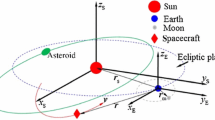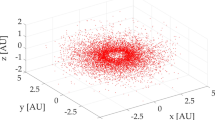Abstract
PROCYON is the world’s first deep-space micro spacecraft launched on December 3, 2014, as a secondary payload on the launch of JAXA’s Hayabusa2 spacecraft. The mission objectives include the high-speed flyby observation of a near-Earth asteroid, which is enabled by utilizing miniature electric propulsion and an Earth swing-by. Through the PROCYON mission design, we encountered a limitation with the zero-radius sphere-of-influence patched-conics approach used in typical mission design. The patched-conics approach could not find a trajectory toward 2000 DP107, the nominal target asteroid, which is attainable only by a distant Earth swing-by under multi-body dynamics. This limitation mainly comes from the low orbital control capabilities of small spacecraft systems. To overcome this difficulty, we propose a preliminary mission design method that quickly calculates low-thrust and gravity assist trajectories using a convex programming approach. The method enables us to search for reachable asteroids extensively under multi-body dynamical systems. We reanalyze the PROCYON mission by the proposed mission design procedure and broadly perform trade studies regarding candidate asteroids in terms of transfer costs and operational requirements. The numerical result demonstrates that the proposed method efficiently finds the nominal target that we could not find by the patched-conics approach.











Similar content being viewed by others
References
IAU Minor Planet Center: Running tallies, minor planets discovered, (accessed 17 2020) (2020)
Oguri, K., Oshima, K., Campagnola, S., Kakihara, K., Ozaki, N., Baresi, N., Kawakatsu, Y., Funase, R.: EQUULEUS Trajectory Design, The Journal of the Astronautical Sciences (2020)
Lockett, T.R., Castillo-Rogez, J., Johnson, L., Matus, J., Lightholder, J., Marinan, A., Few, A.: Near-earth Asteroid Scout Flight Mission. IEEE Aerospace and Electronic Systems Magazine 35, 20–29 (2020)
Bosanac, N., Cox, A.D., Howell, K.C., Folta, D.C.: Trajectory design for a cislunar CubeSat leveraging dynamical systems techniques: The Lunar IceCube mission. Acta Astronautica 144, 283–296 (2018)
Funase, R., Inamori, T., Ikari, S., Ozaki, N., Koizumi, H., Tomiki, A., Kobayashi, Y., Kawakatsu, Y.: Initial Operation Results of a 50Kg-Class Deep Space Exploration Micro-Spacecraft PROCYON. In: 29Th Annual AIAA/USU Conference on Small Satellite (2015)
Funase, R., Inamori, T., Ikari, S., Ozaki, N., Nakajima, S., Koizumi, H., Tomiki, A., Kobayashi, Y., Kawakatsu, Y.: One-year deep space flight result of the world’s first full-scale 50kg-class deep space probe procyon and its future perspective. In: 30th Annual AIAA/USU Conference on Small Satellite, (Utah, USA), 8 2016. SSSC16-III-05 (2016)
Campagnola, S., Ozaki, N., Sugimoto, Y., Yam, C.H., Hongru, C., Kawabata, Y., Ogura, S., Sarli, B., Kawakatsu, Y., Funase, R., Nakasuka, S.: Low-Thrust Trajectory Design and Operations of PROCYON The First Deep-space Micro-spacecraft. In: 25Th International Symposium on Space Flight Dynamics, No. 1, pp. 1–14 (2015)
Vasile, M., Pascale, P.D.: Preliminary design of multiple Gravity-Assist trajectories. J. Spacecr. Rocket. 43(4), 794–805 (2006)
Sarli, B.V., Kawakatsu, Y., Arai, T.: Design of a Multiple Flyby Mission to the Phaethon–Geminid complex. Journal of Spacecraft and Rockets 52, 739–745 (2015)
Casalino, L., Colasurdo, G., Pastrone, D.: Optimal Low-Thrust Escape Trajectories Using Gravity assist. Journal of Guidance, Control, and Dynamics 22, 637–642 (1999)
Morante, D., Sanjurjo Rivo, M., Soler, M.: Multi-objective Low-Thrust Interplanetary Trajectory Optimization Based on Generalized Logarithmic spirals. Journal of Guidance, Control, and Dynamics, 42, 476–490 (2019)
Vandenberghe, L., Boyd, S.: Semidefinite programming. Society for Industrial and Applied Mathematics Review 38(1), 49–95 (1996)
Acikmese, B., Ploen, S.R.: Convex programming approach to powered descent guidance for mars landing. Journal of Guidance Control and Dynamics 30(5), 1353 (2007)
Liu, X., Shen, Z.: Rapid smooth entry trajectory planning for high Lift/Drag hypersonic glide vehicles. J. Optim. Theory Appl. 168(3), 917–943 (2016)
Braun, D.J., Chen, Y., Li, L.: Operational Space Control Under Actuation Constraints Using Strictly Convex Optimization. IEEE Transactions on Robotics 36, 302–309 (2020)
Wiesemann, W., Kuhn, D., Sim, M.: Distributionally Robust Convex optimization. Operations Research 62, 1358–1376 (2014)
Ahmadi, A.A., Majumdar, A.: Some applications of polynomial optimization in operations research and Real-Time decision making. Optim. Lett. 10 (4), 1–16 (2015)
Chan, S., Chen, H., Pun, C.: The design of digital all-pass filters using second-order cone programming (SOCP). IEEE Transactions on Circuits and Systems II: Express Briefs 52(2), 66–70 (2005)
Jiang, A., Kwan, H.K., Zhu, Y.: Peak-Error-Constrained Sparse FIR filter design using iterative SOCP. Ieee Transactions on Signal Processing 60 (8), 4035–4044 (2012)
Cui, X.T., Zheng, X.J., Zhu, S.S., Sun, X.L.: Convex relaxations and MIQCQP reformulations for a class of cardinality-constrained portfolio selection problems. J. Glob. Optim. 56(4), 1409–1423 (2013)
Wu, L., Feng, Y., Palomar, D.P.: General sparse risk parity portfolio design via successive convex optimization. Signal Processing 170, 107433 (2020)
Kocuk, B., Dey, S.S., Sun, X.A.: Strong SOCP Relaxations for the Optimal Power Flow problem. Operations Research 0205(Carpentier 1962), 1–40 (2015)
Starek, J.A., Schmerling, E., Maher, G.D., Barbee, B.W., Pavone, M.: Fast, safe, Propellant-Efficient spacecraft motion planning under Clohessy–Wiltshire–Hill dynamics. Journal Of Guidance Control and Dynamics 94305, 1–21 (2016)
Pinson, R.M., Lu, P.: Trajectory Design Employing Convex Optimization for Landing on Irregularly Shaped asteroids. Journal of Guidance Control and Dynamics 41, 1243–1256 (2018)
Nesterov, Y., Nemirovski, A.: Interior-point polynomial algorithms in convex programming. Society for Industrial and Applied Mathematics (1994)
Gill, P.E., Murray, W., Saunders, M.A.: SNOPT: An SQP algorithm for large-scale constrained optimization. SIAM Rev. 47, 99–131 (2005)
Grant, M., Boyd, S.: Graph Implementations for Nonsmooth Convex Programs. In: Blondel, V., Boyd, S., Kimura, H. (eds.) Recent Advances in Learning and Control. Lecture Notes in Control and Information Sciences, pp. 95–110, Springer Limited (2008)
Grant, M., Boyd, S.: CVX: Matlab software for disciplined convex programming, version 2.1. http://cvxr.com/cvx (2014)
Campagnola, S., Russell, R.P.: The endgame problem part 1: V-Infinity leveraging technique and the leveraging graph. Journal of Guidance Control and Dynamics 2, 33 (2010)
Gooding, R.H.: A procedure for the solution of lambert’s orbital boundary-value problem. Celest. Mech. Dyn. Astron. 48(2), 145–165 (1990)
Koizumi, H., Nakatsuka, J., Komurasaki, K., Kawahara, H., Yaginuma, K., Asakawa, J., Nakagawa, Y., Nakamura, Y., Kojima, S., Matsuguma, T., Funase, R.: Initial flight operations of the miniature propulsion system installed on small space probe: procyon. Transactions of the Japan Society for Aeronautical and Space Sciences Aerospace Technology Japan 14, 13–22 (2016)
Watanabe, S.-I., Tsuda, Y., Yoshikawa, M., Tanaka, S., Saiki, T., Nakazawa, S.: Hayabusa2 mission overview. Space Sci. Rev. 208, 3–16 (2017)
Ozaki, N., Funase, R., Nakajima, S., Yam, C.H., Campagnola, S., Sarli, B., Sugimoto, Y., Hongru, C., Ogura, S., Kawakatsu, Y., Nakasuka, S.: Preliminary Mission Design of PROCYON: a Micro Spacecraft to Asteroid. In: 24Th International Symposium on Space Flight Dynamics (2014)
Sims, J.A., Flanagan, S.N.: Preliminary design of low-thrust interplanetary missions. In: AAS/AIAA Astrodynamics Specialist Conference, (Girdwood, Alaska), 8. AAS 99-338 (1999)
Dymock, R.: The h and g magnitude system for asteroids. Journal of the British Astronomical Association 117(6), 342–343 (2007)
Acknowledgements
The authors would like to thank the members of the PROCYON mission analysis team for their support of the flight trajectory design: Yoshihide Sugimoto, Chit Hong Yam, Stefano Campagnola, Bruno Sarli, Hongru Chen, Yosuke Kawabata, Satoshi Ogura, and Yasuhiro Kawakatsu. Naoya Ozaki would like to thank Mr. Roger Gutierrez Ramon and Mr. Ferran Gonzalez-Franquesa (SOKENDAI) for his valuable comments. The first author also acknowledges the support from JSPS KAKENHI Grant Number 19K15214. Kenshiro Oguri acknowledges financial support for his Ph.D. study from Masason Foundation.
Author information
Authors and Affiliations
Corresponding author
Additional information
Publisher’s Note
Springer Nature remains neutral with regard to jurisdictional claims in published maps and institutional affiliations.
Appendices
Appendix A: Calculation of Partial Derivatives
The partial derivative \(\frac {\partial \mathrm {F}_{k}}{\partial \mathrm {x}_{k}}\), or the STM, is numerically calculated by propagating the following ordinary differential equation between [tk,tk+ 1]. Taking the partial derivatives of Eq. 1 with respect to xk yields
where
Note that u = uk (fixed) between [tk,tk+ 1). Changing the order of the differentiation yields
where both partial derivatives \(\frac {\partial \mathrm {a}}{\partial \mathrm {r}}\) and \(\frac {\partial \mathrm {a}}{\partial \mathrm {v}}\) are evaluated at (t,x,u). The initial value of this ordinary differential equation is
by the definition of the STM. The partial derivative \(\frac {\partial \mathrm {F}_{k}}{\partial \mathrm {u}_{k}}\) is also computed by replacing xk by uk. This paper approximates \(\frac {\partial \mathrm {F}_{k}}{\partial \mathrm {u}_{k}}\) by \(\frac {\partial \mathrm {F}_{k}}{\partial \mathrm {v}_{k}}{\varDelta } t\) and simplifies the computation of the partial derivatives.
Appendix B: Maximum and Minimum Reachable Solar Distance
Suppose that the Earth is orbiting in a circular motion. Then the velocity of the Earth is
Let us calculate the reachable maximum solar distance, that is, the aphelion radius ra. From the assumption, the spacecraft has the Earth swing-by at the perihelion. The spacecraft velocity at the Earth swing-by is
From the vis-viva equation and the conservation of the angular momentum
we obtain
Eliminating va in the equation of the angular momentum conservation and solving the equations for ra yields
As for the reachable minimum solar distance, that is, the perihelion radius rp, the spacecraft has the Earth swing-by at the aphelion, and the spacecraft velocity at the swing-by is
Solving the vis-vita equation and the equation of angular momentum conservation yields the perihelion radius
Appendix C: Computation of Pericenter Position and Velocity from V-infinity Vectors
Given \(\mathrm {v}_{\infty }^{\text {in}}\) and \(\mathrm {v}_{\infty }^{\text {out}}\) such that \(\|\mathrm {v}_{\infty }^{\text {in}}\|=\|\mathrm {v}_{\infty }^{\text {out}}\|\), let us find the pericenter position rp and velocity vp. The deflection angle is calculated as
Using the basic equations of the Kepler orbits, we can calculate the norm of the perigee radius and velocity as
Finally, the pericenter position and velocity vectors are calculated as
where \(\mathrm {z} = (\mathrm {v}_{\infty }^{\text {in}}\times \mathrm {v}_{\infty }^{\text {out}})/(\|\mathrm {v}_{\infty }^{\text {in}}\times \mathrm {v}_{\infty }^{\text {out}}\|)\).
Appendix D: Asteroid Observable Duration
In asteroid flyby missions, the spacecraft usually observes the approaching asteroid for the identification and optical navigation. Therefore, the asteroid observable duration should be long enough for these operations. Let us calculate the asteroid observable duration in this section.
The maximum observable distance of the asteroid from the spacecraft can be computed as follows [35]
where Δ(au) is the limiting distance between the asteroid and spacecraft, rS(au) is the distance of the asteroid from the Sun, V is the limiting magnitude of the telescope, H and G are respectively the absolute magnitude and slope parameter of the asteroid, and ϕ1 and ϕ2 are defined as
where A1 = 3.33,A2 = 1.87,B1 = 0.63,B2 = 1.22, and α is the Sun-asteroid-spacecraft angle during the approach. For example, α = 0 if the asteroid is fully illuminated. The H and G values are taken from The MPC Orbit (MPCORB) Database of the IAU Minor Planet Center.
The observable duration of the asteroid is evaluated as
where Δ is defined in Eq. D.1 and Vrel is the relative velocity of the spacecraft with respect to the asteroid.
Appendix E: Comparison between CP and NLP Solutions
Figures 12 and 13 illustrate the control profiles and trajectories of Phase 1 towards 2000 DP107, the primary candidate in Table 3, under a N-body dynamical system. This result shows that the control profiles of the first thrusting arc resemble each other, but the second thrusting arc appears only for the CP solution.
Rights and permissions
About this article
Cite this article
Ozaki, N., Oguri, K. & Funase, R. PROCYON Mission Reanalysis: Low-Thrust Asteroid Flyby Trajectory Design leveraging Convex Programming. J Astronaut Sci 69, 1–27 (2022). https://doi.org/10.1007/s40295-021-00299-4
Accepted:
Published:
Issue Date:
DOI: https://doi.org/10.1007/s40295-021-00299-4






